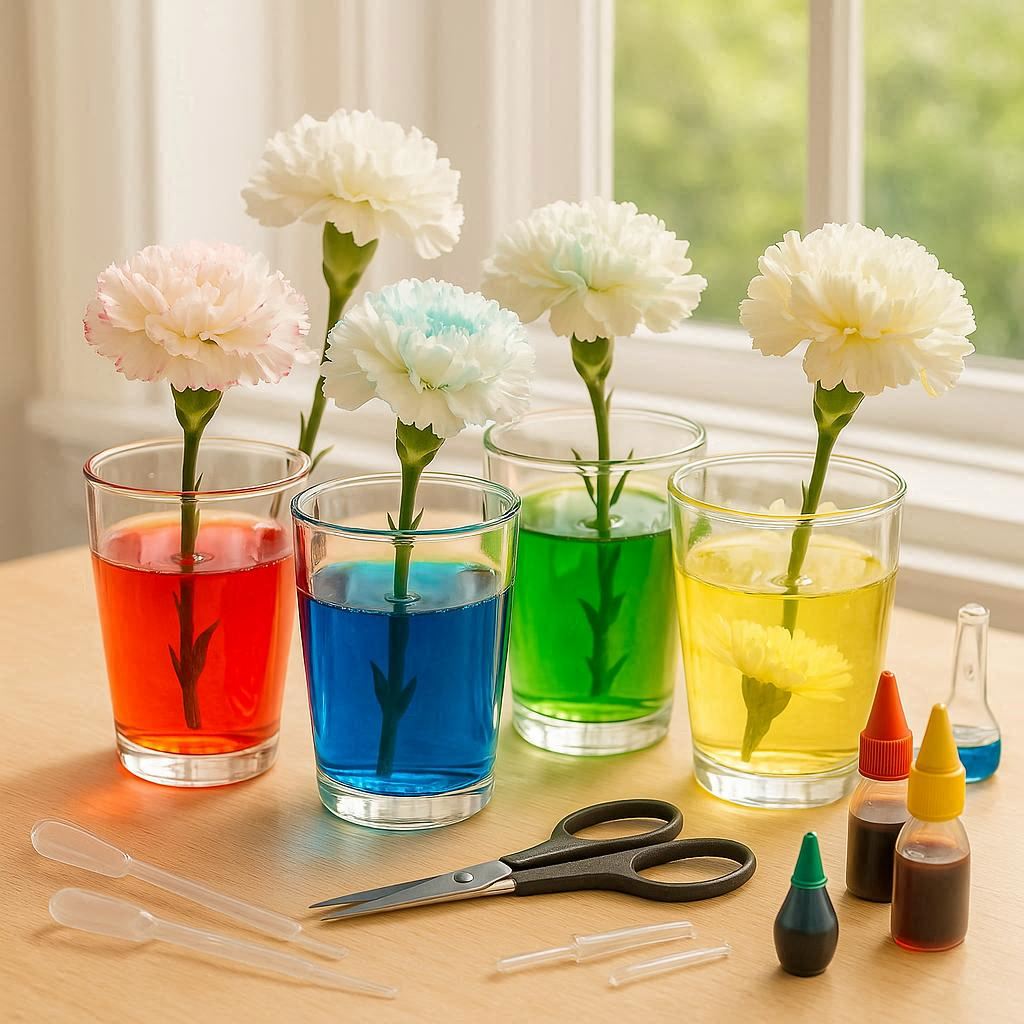Have you ever wondered why leaves change their colors during different seasons? While many of us admire the vibrant hues of autumn leaves, few understand the science behind these transformations. The colors of leaves are not just a result of environmental factors; they are also influenced by the complex interplay of various pigments within the leaf. These pigments include chlorophyll, carotenoids, and anthocyanins, each contributing to the leaf’s color palette. However, to truly appreciate these pigments, we need to delve into the world of chromatography—a scientific technique that helps us separate, identify, and analyze these hidden colors.
In this blog post, we will explore the fascinating world of leaf pigments and how chromatography plays a crucial role in unveiling their hidden diversity. By the end of this article, you will have a better understanding of the science behind the colors of leaves and how chromatography can be used to study these natural wonders.
Understanding Leaf Pigments
Before we dive into the world of chromatography, let us first understand the different types of pigments found in leaves. Leaves contain several types of pigments, each responsible for absorbing specific wavelengths of light and contributing to the overall color of the leaf.
- Chlorophyll
Chlorophyll is the most abundant pigment in leaves and is responsible for their green color. Chlorophyll plays a crucial role in photosynthesis, the process by which plants convert sunlight into energy. There are two types of chlorophyll: chlorophyll a and chlorophyll b. Both types of chlorophyll absorb light in the blue and red wavelengths but reflect green light, which is why leaves appear green during the growing season.
- Carotenoids
Carotenoids are another type of pigment found in leaves. These pigments are responsible for the yellow, orange, and brown colors of leaves. Carotenoids are present in leaves throughout the growing season but are often masked by the green color of chlorophyll. As the days shorten and chlorophyll levels decrease in the fall, the carotenoids become more visible, contributing to the autumn colors we see.
- Anthocyanins
Anthocyanins are responsible for the red and purple colors in leaves. These pigments are not present in leaves throughout the growing season; instead, they are produced in the fall as the days shorten and the weather cools. Anthocyanins are thought to play a role in protecting the leaf from excessive sunlight and aiding in the recycling of nutrients as the leaf senescences (ages).
What is Chromatography?
Chromatography is a laboratory technique used to separate, identify, and analyze the components of a mixture. The term ‘chromatography’ is derived from the Greek words ‘chroma’ (color) and ‘graphe’ (writing), which refers to the use of color in separating substances.
In chromatography, a mixture is applied to a stationary phase, and a mobile phase is then passed through the stationary phase. The components of the mixture are separated based on their interaction with the stationary and mobile phases. The mobile phase can be a liquid or gas, and the stationary phase can be a solid or liquid supported on a solid.
Chromatography is widely used in various fields, including chemistry, biology, and environmental science, for analyzing and separating pigments, drugs, environmental pollutants, and more. In this article, we will focus on how chromatography is used to separate and identify the pigments in leaves.
A Closer Look at Leaf Pigments
Now that we have discussed the different types of pigments in leaves, let us take a closer look at how these pigments contribute to the color of leaves and how chromatography can be used to separate and identify them.
- Chlorophyll
Chlorophyll is the most abundant pigment in leaves and is responsible for their green color. Chlorophyll a and chlorophyll b are the two types of chlorophyll found in leaves. Chlorophyll a is more abundant and is responsible for the blue-green color of leaves, while chlorophyll b is responsible for the yellow-green color. Both types of chlorophyll are essential for photosynthesis and are found in the chloroplasts of leaf cells.
- Carotenoids
Carotenoids are a class of pigments that are responsible for the yellow, orange, and brown colors of leaves. These pigments are present in leaves throughout the growing season but are often masked by the green color of chlorophyll. In the fall, as the days shorten and the weather cools, the production of chlorophyll slows down, and the carotenoids become more visible, contributing to the autumn colors we see.
- Anthocyanins
Anthocyanins are responsible for the red and purple colors in leaves. These pigments are not present in leaves throughout the growing season; instead, they are produced in the fall as the days shorten and the weather cools. Anthocyanins are thought to play a role in protecting the leaf from excessive sunlight and aiding in the recycling of nutrients as the leaf senescences (ages).
Chromatography in Action
Chromatography is a powerful tool for separating and identifying the pigments in leaves. In this section, we will discuss how chromatography is used to separate leaf pigments and how this technique can help us better understand the hidden colors of leaves.
- Separation of Pigments Using Chromatography
Chromatography can be used to separate the different pigments in leaves based on their solubility and interaction with the stationary and mobile phases. The most common type of chromatography used for separating leaf pigments is paper chromatography.
In paper chromatography, a strip of chromatography paper is spotted with a sample of leaf extract containing the pigments. The paper is then placed in a jar containing a solvent, such as a mixture of water and ethanol. The solvent moves up the paper by capillary action, carrying the pigments with it. The pigments separate based on their solubility in the solvent and their interaction with the paper. Chlorophyll, carotenoids, and anthocyanins each have different affinities for the stationary phase and the mobile phase, causing them to separate into distinct bands on the chromatography paper.
- Identifying Pigments Using Chromatography
Once the pigments have been separated using chromatography, they can be identified by their positions on the chromatography paper. Each pigment has a characteristic retention factor, which is the ratio of the distance traveled by the pigment to the distance traveled by the solvent front. The retention factor is influenced by the solubility of the pigment in the solvent and its interaction with the stationary phase.
Chlorophyll a and chlorophyll b have different retention factors and can be distinguished from each other based on their positions on the chromatography paper. Carotenoids also have distinct retention factors and can be identified based on their positions. Anthocyanins, on the other hand, may not be visible on the chromatography paper because they are often present in smaller amounts and may not move far from the point of origin.
DIY Chromatography Experiment: Unveiling the Hidden Colors of Leaves
Now that we have discussed the different types of pigments in leaves and how chromatography can be used to separate and identify them, let us conduct a simple chromatography experiment at home to unveil the hidden colors of leaves.
Materials Needed:
- Fresh leaves (green, yellow, orange, red, or purple)
- Scissors
- A coffee filter or chromatography paper
- A pencil
- A jar or tall glass
- Water
- Ethanol (rubbing alcohol)
- A ruler
- A marker
Instructions:
- Prepare the Leaf Extract
- Collect a few fresh leaves of your choice. The leaves can be green, yellow, orange, red, or purple, depending on the pigments you want to study.
- Using scissors, cut the leaves into small pieces to increase the surface area for extraction.
- Place the cut leaves in a jar or tall glass. Add a small amount of water and a few drops of ethanol (rubbing alcohol) to help dissolve the pigments.
- Crush the leaves using a spoon or other blunt object to release the pigments into the solvent. Let the mixture sit for a few minutes to allow the pigments to dissolve.
- Prepare the Chromatography Paper
- Cut a strip of chromatography paper or a coffee filter to the desired length. Draw a line at the bottom of the paper using a pencil. This line will serve as the point where the leaf extract will be applied.
- Using a marker, label the top and bottom of the paper so that you can keep track of the direction in which the solvent will move.
- Apply the Leaf Extract
- Dip a small brush or cotton swab into the leaf extract and carefully apply a small spot to the pencil line on the chromatography paper. Be careful not to make the spot too large, as this can cause the pigments to overlap.
- Allow the spot to dry completely before proceeding. You can speed up the drying process by gently blowing on the spot.
- Set Up the Chromatography Jar
- Fill the jar or tall glass with a small amount of water. Add a few drops of ethanol to the water to help move the pigments up the paper.
- Stir the mixture gently to combine the solvents.
- Run the Chromatography
- Place the chromatography paper into the jar, making sure that the bottom of the paper is in contact with the solvent. The top of the paper should extend above the jar to prevent the solvent from spilling over.
- Cover the jar with a lid or plastic wrap to prevent evaporation of the solvent and to ensure that the chromatography runs evenly.
- Allow the chromatography to run until the solvent front has reached the top of the paper. This may take several minutes to an hour, depending on the solvents used and the length of the paper.
- Analyze the Results
- Once the chromatography has run, remove the paper from the jar and allow any excess solvent to drip off.
- Observe the separated pigments on the chromatography paper. The different pigments will appear as distinct bands of color, each at a different position on the paper.
- Use a ruler to measure the distance each pigment has traveled from the point of origin to its position on the paper. This will help you determine the retention factor for each pigment.
- Compare your results with the known retention factors for leaf pigments to identify which pigments are present in your leaf extract.
Conclusion
The hidden colors of leaves are a fascinating subject that combines biology, chemistry, and the beauty of nature. By understanding the different pigments present in leaves and how they contribute to the leaf’s color, we can gain a deeper appreciation for the complex processes that occur within plants. Chromatography is a powerful tool that allows us to separate and identify these pigments, enabling us to study their properties and behavior in greater detail.
In this blog post, we have explored the different types of pigments in leaves, the principles of chromatography, and how chromatography can be used to separate and identify these pigments. We have also conducted a simple chromatography experiment at home to unveil the hidden colors of leaves. By following the steps outlined in this article, you can conduct your own chromatography experiments and explore the fascinating world of leaf pigments for yourself.
So the next time you see a colorful leaf, remember the hidden pigments that contribute to its beauty and the role that chromatography plays in helping us understand and appreciate these natural wonders. Who knows, maybe you’ll be inspired to explore other ways to study plant pigments or even pursue a career in plant biology or analytical chemistry. The possibilities are endless when you have the tools of science to guide you in your journey of discovery.



